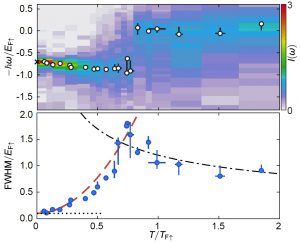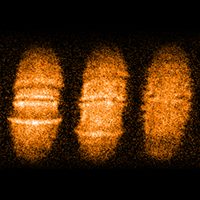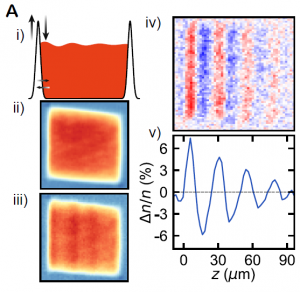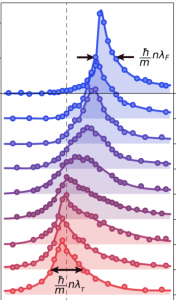- Thermography of the superfluid transition in a strongly interacting Fermi gas (2/14/2024)
Zhenjie Yan, Parth B. Patel, Biswaroop Mukherjee, Chris J. Vale, Richard J. Fletcher, Martin Zwierlein
preprint version https://arxiv.org/abs/2212.13752
Heat transport can serve as a fingerprint identifying different states of matter. In a normal liquid, a hotspot diffuses, whereas in a superfluid, heat propagates as a wave called “second sound.” Direct imaging of heat transport is challenging, and one usually resorts to detecting secondary effects. In this study, we establish thermography of a strongly interacting atomic Fermi gas, whose radio-frequency spectrum provides spatially resolved thermometry with subnanokelvin resolution. The superfluid phase transition was directly observed as the sudden change from thermal diffusion to second-sound propagation and is accompanied by a peak in the second-sound diffusivity. This method yields the full heat and density response of the strongly interacting Fermi gas and therefore all defining properties of Landau’s two-fluid hydrodynamics.
- Universal Sound Diffusion in a Strongly Interacting Fermi Gas (12/4/2020)
Parth B. Patel, Zhenjie Yan, Biswaroop Mukherjee, Richard J. Fletcher, Julian Struck, Martin W. Zwierlein
Science 370, 1222-1226 (2020)
MIT News: Physicists capture the sound of a “perfect” fluid
BBC Radio 4:
Radio podcasts: WGBH Radio
New Scientist, Popular Mechanics
Transport of strongly interacting fermions governs modern materials — from the high-Tc cuprates to bilayer graphene –, but also nuclear fission, the merging of neutron stars and the expansion of the early universe. Here we observe a universal quantum limit of diffusivity in a homogeneous, strongly interacting Fermi gas of atoms by studying sound propagation and its attenuation via the coupled transport of momentum and heat. In the normal state, the sound diffusivity D monotonically decreases upon lowering the temperature T, in contrast to the diverging behavior of weakly interacting Fermi liquids. As the superfluid transition temperature is crossed, D attains a universal value set by the ratio of Planck’s constant h and the particle mass m. This finding of quantum limited sound diffusivity informs theories of fermion transport, with relevance for hydrodynamic flow of electrons, neutrons and quarks.
- Congratulations to Dr. Richard Fletcher on his Assistant Professorship at MIT (3/29/2020)
We are all excited for Rich to be starting his own research group at MIT!
- Spectral response and contact of the unitary Fermi gas (2/26/2019)
Biswaroop Mukherjee, Parth B. Patel, Zhenjie Yan, Richard J. Fletcher, Julian Struck, Martin W. Zwierlein
Spectral response and contact of the unitary Fermi gas
We measure radiofrequency (rf) spectra of the homogeneous unitary Fermi gas at temperatures ranging from the Boltzmann regime through quantum degeneracy and across the superfluid transition. For all temperatures, a single spectral peak is observed. Its position smoothly evolves from the bare atomic resonance in the Boltzmann regime to a frequency corresponding to nearly one Fermi energy at the lowest temperatures. At high temperatures, the peak width reflects the scattering rate of the atoms, while at low temperatures, the width is set by the size of fermion pairs. Above the superfluid transition, and approaching the quantum critical regime, the width increases linearly with temperature, indicating non-Fermi-liquid behavior. From the wings of the rf spectra, we obtain the contact, quantifying the strength of short-range pair correlations. We find that the contact rapidly increases as the gas is cooled below the superfluid transition.
- Boiling a Unitary Fermi Liquid (11/1/2018)
 Zhenjie Yan, Parth B. Patel, Biswaroop Mukherjee, Richard J. Fletcher, Julian Struck, Martin W. Zwierlein
Zhenjie Yan, Parth B. Patel, Biswaroop Mukherjee, Richard J. Fletcher, Julian Struck, Martin W. ZwierleinPhys. Rev. Lett. 122, 093401 (2019)
See Viewpoint by Pietro Massignan: From Quantum Quasiparticles to a Classical Gas
We study the thermal evolution of a highly spin-imbalanced, homogeneous Fermi gas with unitarity limited interactions, from a Fermi liquid of polarons at low temperatures to a classical Boltzmann gas at high temperatures. Radio-frequency spectroscopy gives access to the energy, lifetime and the short-range correlations of Fermi polarons at low temperatures T. In this regime we observe a characteristic $\propto T^2$ dependence of the spectral width, corresponding to the quasiparticle decay rate expected for a Fermi liquid. At high T the spectral width decreases again towards the scattering rate of the classical, unitary Boltzmann gas, $\propto T^{1/2}$. In the transition region between the quantum degenerate and classical regime, the spectral width attains its maximum, on the scale of the Fermi energy, indicating the breakdown of a quasiparticle description. Density measurements in a harmonic trap directly reveal the majority dressing cloud surrounding the minority spins, and yield the compressibility along with the effective mass of Fermi polarons.
- Congratulations to Dr. Julian Struck for receiving the CNRS Junior Research Chair at ENS Paris (8/1/2017)
All the best of luck to Julian!
- Homogeneous Atomic Fermi Gases (10/31/2016)

Biswaroop Mukherjee, Zhenjie Yan, Parth B. Patel, Zoran Hadzibabic, Tarik Yefsah, Julian Struck, Martin W. Zwierlein Phys. Rev. Lett. 118, 123401 (2017), arXiv:1610.10100

We report on the creation of homogeneous Fermi gases of ultracold atoms in a uniform potential. In the momentum distribution of a spin-polarized gas, we observe the emergence of the Fermi surface and the saturated occupation of one particle per momentum state. This directly confirms Pauli blocking in momentum space. For the spin-balanced unitary Fermi gas, we observe spatially uniform pair condensates. For thermodynamic measurements, we introduce a hybrid potential that is harmonic in one dimension and uniform in the other two. The spatially resolved compressibility reveals the superfluid transition in a spin-balanced Fermi gas, saturation in a fully polarized Fermi gas, and strong attraction in the polaronic regime of a partially polarized Fermi gas.
- Congratulations to Dr. Tarik Yefsah for starting his position as CNRS Permanent Researcher (8/1/2016)
All the best to Tarik for a continued string of wonderful discoveries.
Check out his latest news: http://www.lkb.upmc.fr/ultracoldfermigases/yefsah/
- Cascade of Solitonic Excitations in a Superfluid Fermi Gas (1/27/2016)

Mark J.-H. Ku, Biswaroop Mukherjee, Tarik Yefsah, and Martin W. Zwierlein Phys. Rev. Lett. 116, 045304 (2016), arXiv:1507.01047
We follow the time evolution of a superfluid Fermi gas of resonantly interacting 6Li atoms after a phase imprint. Via tomographic imaging, we observe the formation of a planar dark soliton, its subsequent snaking, and its decay into a vortex ring, which in turn breaks to finally leave behind a single solitonic vortex. In intermediate stages we find evidence for an exotic structure resembling the Φ-soliton, a combination of a vortex ring and a vortex line. Direct imaging of the nodal surface reveals its undulation dynamics and its decay via the puncture of the initial soliton plane. The observed evolution of the nodal surface represents dynamics beyond superfluid hydrodynamics, calling for a microscopic description of unitary fermionic superfluids out of equilibrium.



